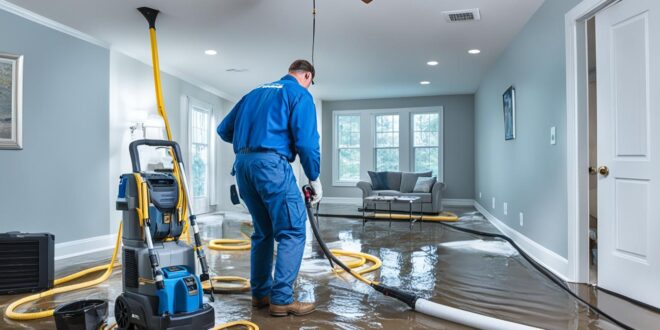Any property, residential or commercial, can suffer from water damage. When water intrusion occurs due to leaks, floods, or plumbing failures, it can lead to a host of problems, with mold growth being one of the most concerning. Mold not only damages building materials but also poses health risks to occupants. This is where professional water damage contractors play a crucial role — their expertise in timely and effective water damage restoration helps prevent mold growth and protects your property and health.
The Connection Between Water Damage And Mold
Mold spores are environmentally present but need moisture to thrive and spread. When water damage is left untreated or improperly addressed, excess moisture provides an ideal environment for mold to thrive. Mold grows on organic materials, including wood, drywall, carpets, and insulation, within 24–48 hours of water exposure.
Mold growth can cause structural damage by weakening materials over time. It releases allergens and irritants that can cause respiratory troubles, allergies, and other health issues for building inhabitants. Therefore, preventing mold is not just about maintaining the integrity of your property but also about safeguarding the health of your family or employees.
The Critical Role Of Water Damage Contractors
Water damage contractors inspect, mitigate, and restore water-damaged homes. Their role extends beyond just drying out the water; they employ comprehensive strategies to prevent mold growth at every stage of the restoration process.
1. Immediate Water Extraction And Drying
One of the most important steps in preventing mold is the rapid removal of water. Water damage contractors use industrial-grade pumps and extraction tools to remove standing water quickly. They use air movers and dehumidifiers to dry impacted areas after extraction.
This immediate intervention drastically reduces the time moisture remains in the structure, cutting off mold’s ability to grow. By carefully monitoring humidity levels throughout the drying process, contractors ensure that affected materials return to safe moisture levels.
2. Thorough Inspection And Moisture Mapping
Before, during, and after drying, water damage contractors conduct detailed inspections using moisture meters, thermal imaging cameras, and hygrometers. They can find hidden moisture pockets behind walls and under flooring using moisture mapping.
This thorough approach prevents mold from developing in concealed areas that could otherwise be overlooked, ensuring a more complete restoration and mold prevention.
3. Removal And Disposal Of Damaged Materials
Some materials damaged by water are highly susceptible to mold growth and must be removed and replaced. Water damage contractors evaluate the extent of damage to materials like drywall, insulation, and carpeting. When these materials are too saturated or contaminated, contractors safely remove and dispose of them according to industry standards.
Proper removal of compromised materials eliminates mold spores and fungal colonies, reducing the risk of mold spreading throughout the property.
4. Cleaning And Sanitizing Affected Areas
After drying and removal, contractors perform thorough cleaning and sanitization of the affected areas. Using EPA-registered antimicrobial agents, they treat surfaces to kill existing mold spores and prevent new mold colonies from forming. Restoring indoor health requires this step.
In some cases, contractors may also perform HEPA vacuuming to remove airborne mold spores, further reducing the risk of mold contamination.
5. Structural Repairs And Prevention Measures
Water damage contractors often coordinate or provide structural repairs after mold prevention steps are complete. Fixing leaks, enhancing ventilation, and sealing water-entry points reduce water damage and mold growth.
In addition, contractors may advise property owners on preventive measures like installing sump pumps, improving drainage, and using moisture barriers in crawl spaces or basements.
Why Hiring Professional Water Damage Contractors Matters?
Many property owners underestimate the complexity and risks associated with water damage restoration. Attempting DIY drying or mold prevention can lead to incomplete remediation, allowing mold to take hold and cause long-term problems.
Professional water damage contractors bring specialized knowledge, equipment, and experience that ensure effective water removal and mold prevention. They adhere to industry standards, which guide best practices for restoration and mold control.
Moreover, contractors can assist with insurance claims by documenting damage and providing detailed reports, helping property owners navigate the financial aspects of water damage restoration.
Conclusion
Mold growth after water damage can harm property and health. Water damage contractors play a pivotal role in preventing mold by swiftly removing water, thoroughly drying and inspecting affected areas, removing damaged materials, and applying professional cleaning and sanitizing methods. Their expertise not only restores your property to its pre-damage condition but also safeguards your indoor environment against the dangers of mold.

